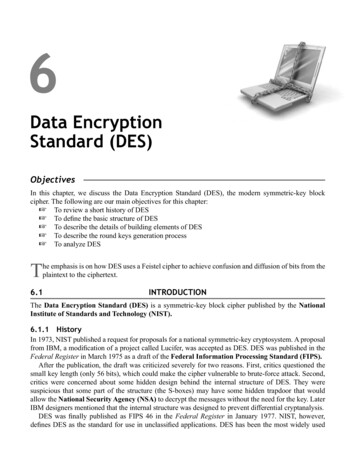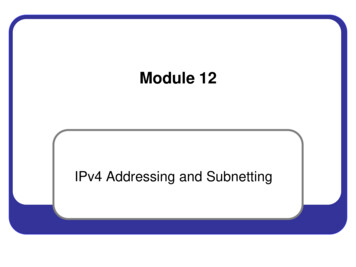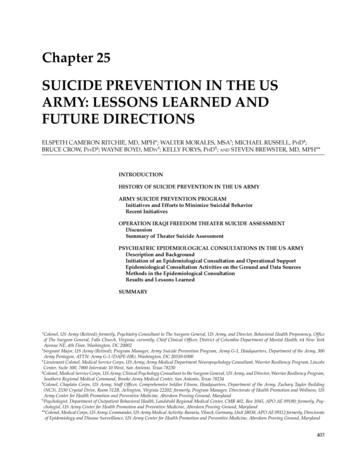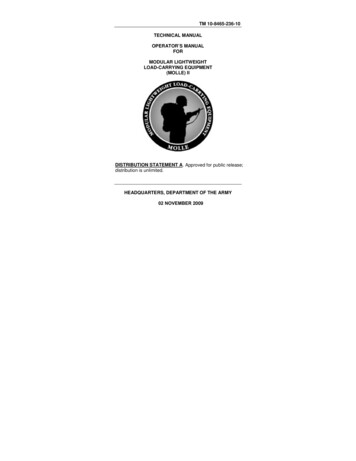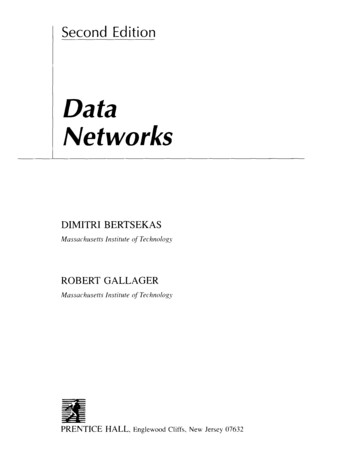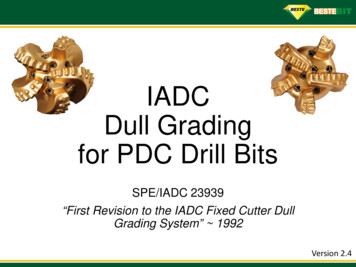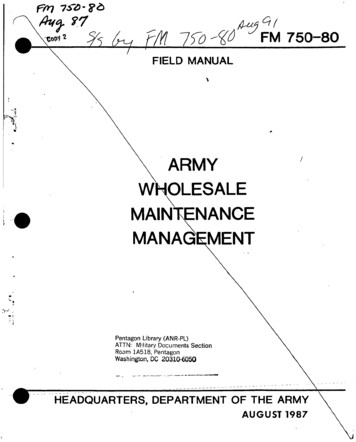
Transcription
û-u-1! (752) '%ô FM 750-80FIELD MANUAL-v*SARMYMAINTENANCEMANAGEMENTPentagon Library (ANR-PL)ATTN: Military Documents SectionRoom 1A518, PentagonWashington, DC 20310-6050HEADQUARTERS, DEPARTMENT OF THE ARMYAUGUST 1987
«Y'iII
*FM 750-80HEADQUARTERSDEPARTMENT OF THE ARMYWASHINGTON, DC, 31 August 1987FIELD MANUALNo. 750-80ARMY WHOLESALE MAINTENANCE MANAGEMENTEffective support of our fighting forces requires a coordinated maintenance system. Neither the wholesalenor retail communities can provide support in isolation from the other. This manual illustrateswholesale maintenance and the wholesale/retail interface.-* 22. PLANNING FOR WHOLESALE MAINTENANCE SUPPORTGeneralIndustrial PreparednessDepot Maintenance Mobilization PlansInterservice SupportHost Nation SupportContract MaintenanceAutomationSupply -22-22-23. MAINTENANCE ENGINEERINGMaintenance Engineering During DevelopmentMateriel FieldingMaintenance Engineering After System DeploymentPerformance DataEquipment Improvement Recommendations (EIR)Logistics Assistance3-13-23-33-43-53-633-33-33-43-43-54. WHOLESALE MAINTENANCE OPERATIONSGeneralDepot Maintenance OperationsElements of Depot MaintenanceOrganic FacilitiesContractor FacilitiesDepot Maintenance PerformedWholesale Maintenance in a Theater of -31.INTRODUCTIONPurpose and ScopeRecommended ChangesExplanation of TermsThe Wholesale Maintenance MissionOrganization for Wholesale Maintenance Management*2-APPENDIX AREFERENCESA-lAPPENDIX BACRONYMSB-l/INDEXIndex-1This manual supersedes FM 750-80,1 September 1983.i
*-r*-
FM 750-80CHAPTER 1INTRODUCTION1-1. Purpose and Scope1-3. Explanation of Termsa.The purpose of thismanual isto establishis the function of susa. Materielmaintenancewholesale materiel maintenance management doctaining materiel in an operational status, restoringtrine. Army Regulation (AR) 700-9, Policies of theit to a serviceable condition, or updating and upArmy Logistics System, 15 October 1981, definesgrading its functional usefulness through modificalogistics doctrine as, “A collection of the besttion and product improvement. The maintenancethinking the Army has to offer on how to performfunction includes varied types of activities pera particular combat service support in wartime.”formed by many different organizational elements.Consequently, the intent of this publication is toThe ultimate goal of these organizations is toprovide information about wholesale maintenancecreate and sustain combat readiness in the Army.which will be useful in planning for and providingBecause maintenance activities are so diverse,support in time of war. Commanders, staff officers,they can be categorized in many different ways. Alogisticians, and nonlogisticians need to know howbasic method of identifying maintenance is towholesale maintenance supports the Army’sdivide it into two subfunctions: maintenance engicombat strength. Not only is this knowledge applineering and maintenance operations.cable to the Active Army, but it is equally applicable to the Army National Guard and the ArmyMAINTENANCE IS:Reserve. This doctrine is for use in war and conSUSTAININGtingency planning, logistics planning, and forceRESTORINGmodernization, as well as in improving everydayUPGRADINGoperations.THIS MANUAL PROVIDES THE DOCTRINEFOR LOGISTICIANS TO PLAN TO OPERATEIN WAR JUST AS WE DO IN PEACE.1-2. Recommended Changesa. Since changes in doctrine are continuallyoccurring, users of this field manual are encouraged to make comments and recommend changeswhich will improve the technical quality of thisdocument.b. When changes are recommended, all comments should be directed to the specific page, paragraph, and line of the text. To ensure understanding and accurate evaluation, it is requested thatreasons for a change be provided for each comment. Comments should be submitted on DA Form2028 (Recommended Changes to Publications andBlank Forms) and forwarded directly to the Commandant, United States Army Logistics Management Center (ALMC), ATTN: AMXMC-MR-MM,Fort Lee, Virginia 23801-6049.b. Maintenance engineering is that activity ofmateriel maintenance which develops concepts,criteria, and technical requirements during themateriel acquisition process. After acquisition,maintenance engineering activities continue toensure timely, effective, and economical maintenance support throughout the entire life cycle.c. Maintenance operations constitute the actualphysical performance of maintenance and themanagement of such performance. Maintenanceoperations are generally divided into three levels.These are unit, intermediate direct support (IDS)and general support (IGS), and depot, as addressedin AR 750-1, Army Materiel Maintenance Concepts and Policies. These levels of maintenanceidentify the scope of the operation which may beperformed at various command levels. The responsibility to perform maintenance within a givenlevel is assigned to a unit or activity under maintenance planning developed during the materielacquisition phase. This, responsibility .is based onmission; degree of mobility and complexity; intended, or availability of personnel; skills; and materiel1-1
FM 750-80resources. The collective objective of each level isto restore materiel to a state of serviceability.MAINTENANCE OPERATIONS RSIONCALIBRATIONRENOVATION(1) Unit maintenance is the preventive andcorrective maintenance performed by a using uniton its own equipment.(2) Intermediate direct support maintenanceunits provide DS to the user by repairing andreturning materiel directly to the user and repairof high usage components for Reparable Exchange(RX).al support and unit levels of maintenance, both inCONUS and overseas. This activity may be in support of contingency operations, an established theater of operations, a deployable unit or command.RETAIL MAINTENANCE:UNITINTERMEDIATE:DSGSe Wholesale maintenance is that maintenanceactivity which is performed above the retail level.The depot level of maintenance performs wholesale maintenance operations. The Army MaterielCommand (AMC) is responsible for memagingwholesale maintenance management. Its headquarters directs the activities of depots, arsenals,and test facilities used in wholesale maintenance.The AMC major subordinate commands (MSCs) develop, procure, distribute and support Army materiel systems. Organizations outside AMC havewholesale maintenance responsibility for some specialized commodities.WHOLESALE MAINTENANCE:MAINTENANCEENGINEERINGIntermediate general support maintenanceDEPOT OPERATIONSIDSU REPAIR & RETURN TO USER(3)units perform those maintenance actions requiredto support a force as a whole, rather than specificelements. Intermediate (GS) maintenance unitsare normally located at echelons above corps andperform maintenance in support of the theatersupply system through the repair of assemblies,components, and modules, RX items, printed circuit boards (FCB), and operational readiness float(ORF).IGSU REPAIR & RETURN TO SUPPLYSYSTEM(4) Depot maintenance is the highest level ofmaintenance, performing those tasks which cannotbe performed at a lower level. It is performed infined facilities in Continental United States(CONUS) and the theater of operations (TO), andis production line oriented.(5) An exception to the above is aviation maintenance. The three levels of aviation maintenanceare aviation unit maintenance (AVUM), aviationintermediate maintenance (AVIM), and aviationdepot maintenance.d. Retail maintenance is the maintenance activity performed at the intermediate direct and gener1-2Wholesale maintenance has but one purpose—tosustain combat readiness of US and Allied forces.This purpose is achieved by: Providing a system for the maintenanceof Army materiel systems. Determining where, when, how, why,and by whom maintenance actions must be taken. Using maintenance data during systemdevelopment to lessen the maintenance requirement and after system fielding to improve maintenance performance.0Conducting depot maintenance. Providing maintenance assistance toretail maintenance organizations.Wholesale maintenance responsibilities are consolidated to take advantage of centralized management, which results in an efficiency of operations.Army wholesale maintenance addresses the Armymaintenance system above the retail level. Whole-
FM 750-80-Vsale maintenance responsibility resides withinsuch Army agencies as: The Surgeon General The Chief of Engineers DA Deputy Chief of Staff for Logistics(DCSLOG) US Army Materiel Command (AMC)a. The Army Materiel Command (AMC). TheAMC is a major Army command (MACOM). It hasmateriel life-cycle responsibility. Functions ofAMC include formulating the materiel portions ofthe DA program and executing approved programs, providing integrated commodity management comprising: Research, development, and modification. Development testing and evaluation. Maintenance support planning, includingpersonnel, training, manuals, repair parts, tools,test equipment, and modifications or product improvements. Technical and engineering supervisionand services, including technical advisory service,product engineering, production engineering,maintenance engineering, and human factors engineering. Army provisioning technical and functional policy and implementation for initial andfollow-on support. Product assurance. Value engineering. Procurement and production. Integrated materiel inventory management. Materiel and industrial mobilizationplanning, contingency planning, and maintenanceof mobilization reserves and production base. Management of the DA equipment publications program and preparation or acquisition ofequipment publications. Technical direction and management ofthe depot maintenance programs. Transportation, transportability, andtransportation engineering. Development and recommendation toHeadquarters, Department of the Army (HQDA) ofnew and improved concepts, maintenance doctrine,and procedures for wholesale logistics operations. Management and control of working capital funds. Development of automated wholesale logistics systems that interface with Army and otherretail logistics systems as well as other DODwholesale systems. Cqnduct of specialized training of personnel in the materiel area, to include new equipmenttraining (NET). Manage central data management program for equipment warranties. Management of the AMC portion of theArmy-Wide Training Literature Program (ATLP);i.e., preparation of Army Wholesale Logistics Literature (AWLL).b. Organization of AMC. AMC is comprised ofthe headquarters, its MSCs, and various other activities and installations.(1) AMC has assigned materiel readiness responsibility to designated MSCs under its control.These designated MSCs are responsible for the integrated management of their commodities. Integrated management includes: Research Development Design Modification Sponsorship of tests and evaluation Initial repair parts planning Tools, test equipment and handlingequipment planning Technical and engineering supervisionand services Product engineering Production engineering Cataloging and standardization Direction of procurement and production Packaging, handling, storage and transportation Readiness Materiel inventory management Mobilization planning Production base planning Preparation of equipment publications New equipment training Army warranty program(2) The major subordinate commands include: US Army Armament, Munitions andChemical Command (AMCCOM)—armament systems and ammunition (Rock Island, IL). US Army Aviation Systems Command(AVSCOM—aircraft (St. Louis, MO). US Army Communications-ElectronicsCommand (CECOM)—communications-electronicssystems (FT. Monmouth, NJ). US Army Missile Command (MICOM)—missiles, rockets, and lasers (Redstone Arsenal,AL). US Army Tank-Automotive Command(TACOM)—tracked and wheeled combat, tactical,and general-purpose vehicles, selected constructionand .materiels, handling equipment (Warren, MI). US Army Troop Support Command(TROSCOM)—field support items, amphibious ve1-3
FM 750-80hieles, watercraft, and related railroad equipment(St. Louis, MO). US Army Deport System Command(DESCOM)—manages all Army supply and maintenance depots (Chambersburg, PA). USArmyLaboratoryCommand(LABCOM)—manages the corporate research anddevelopment laboratories and provides intensiveintegrated management of the entire AMC technology base (Adelphi, MD). US Army Test & Evaluation Command(TECOM)—conducts all developmental testing andevaluation of Army weapons and equipment (Aberdeen Proving Ground, MD). US Army Security Affairs Command(US AS AC)—supports America’s security interestsand those of its allies through international defense cooperation programs involving hardware,training, and publications. It also manages DOD’sparticipation in selected NATO programs (Alexandria, VA).c. MSC Organization for Maintenance.(1) General. The organization of a particularMSC within AMC is somewhat dependent uponthe peculiarities of the support structure of theassigned commodity. The following are the functional elements common to MSCs regardless ofcommodity: Maintenance Materiel Management Procurement and Production Project Managers Special Staff International Logistics Resources Management Product Assurance Personnel Training and Force Development Plans and Systems Analysis Management Information Systems Field/Liaison Services ReadinessThe coordination of the above elements is critical.With respect to maintenance, the MSCs have twodirectors who coordinate and supervise the majority of maintenance engineering and depot maintenance operations. They are the Director for Maintenance, responsible for the National MaintenancePoint (NMP), and the Director for Materiel Management, responsible for the National InventoryControl Point (NICP).(2) Scope of NMP Opeations. The NMP plays avital role in system/item development and operation. Through maintenance engineering, designcharacteristics and support concepts are built intoa new system. The NMP contines to track the1-4system throughout its life-cycle, gathering operational performance data and modifying systemsupport (or coordinating with the system engineerto modify the system) as needed. The NMP is thekey to the success of the AMC Maintenance Management Program. Its activities are influenced to aconsiderable degree by the requirements of theNICP which is responsible for the inventory management of the system. Inventory management includes the procuring, stocking, and issuing ofsystem/item/component and repair parts/tools/test equipment to support the maintenance requirements of the system and includes programming the worldwide depot maintenance supportrequirements. The NMP has worldwide technicalmaintenance responsibility for a specific commodity or group of commodities (items of similar characteristic; e.g., communications equipment, vehicles, aircraft, etc.). Additionally, the NMP is responsible for providing Army depots with technicalworking-level direction relative to the maintenance support required for its commodity group.The scope of the maintenance management responsibilities of the NMP extends from the earlyconceptual stages of materiel acquisition throughthe design, development, procurement, production,use, and disposal stages. Specifically, the majorfunctions of an NMP are in the areas of maintenance engineering, supoort planning, publications,and technical assistance (when required). The responsibilities of the NMP for the particular itemor commodity continue throughout its life cycle.The operations of the NMP and the NICP must beclosely coordinated to ensure adequate technicaland administrative resources required to meet theneeds of the equipment user and maintenance support elements are available. Appropriate NMP’smay be identified by end item NSN as listed in AR750-1, appendix C.(3)tion (SMCA). AMCCOM is responsible for DODwide maintenance of conventional ammunition asthe Single Manager for Conventional Ammunition(SMCA). The AMCCOM Defense Ammunition Directorate serves as the National Inventory ControlPoint (NICP) and the National Maintenance Point(NMP) for Army and SMCA conventional ammunition, lethal toxic chemical ammunition, and ammunition peculiar equipment (APE), the SMCAdepot level maintenance program for conventionalammunition at US Army Depot System Command,AMCCOM, and OCONUS installations in managedwithin each activity by a Defense Ammunition Directorate.
FM 750-80d.US Army Deport System Command(DESCOM). DESCOM is responsible for the command and control of assigned US Army depots anddepot activities. Depot missions are receipt, storage, issue and maintenance of assigned commodities. Except for the SMCA depot-level maintenance managed worldwide by AMCCOM, DESCOMmanages the use of funds, manpower, physicalplants and equipment required for depot maintenance worldwide. The information needed tomanage depot maintenance operations is consolidated in a DESCOM data bank. This data bank isa source of data for reports to higher headquarters. Chapter 4, Wholesale Maintenance Operations, provides detailed information on missionsand locations of depots and depot activities.*-V»1-5
«
CHAPTER 2PLANNING FOR WHOLESALE MAINTENANCE SUPPORT2-1. GeneralThe maintenance plan is a description of the requirements and tasks to be accomplished forachieving, restoring, or maintaining the operational capability of a system, equipment, or facility.The maintenance support plan is normally a partof the Integrated Logistic Support Plan (ILSP).Maintenance plans provide many necessary components which make military operations successful. Maintenance requirements are influenced bythe threat, the operational plans, and the requirements of the other functions of logistics.MAINTENANCE SUPPORT PLANNING IS AKEY TO SUCCESSFUL MILITARYOPERATIONS.2-2. Industrial Preparednessa. Industrial preparedness denotes an ability tomanufacture or maintain materiel in an industrialfacility, whether the facility is commercial or Government owned (organic). The Army is concernedboth with the production capacity of commercialsources and their capacity to perform depot maintenance during and after mobilization. The maintenance capacity of organic depots, on the otherhand, is used primarily for maintenance and notfor manufacture. Depots manufacture componentsor parts that are not readily available from manufacturers to meet overhaul schedules.b. The intent of industrial preparedness is toprovide industrial capability ami capacity sufficient to sustain varying levels of combat, includingfull-scale war, without duplication of facilities orexcess capacity. Both commercial and Governmentowned sources are appropriate for use during andafter mobilization to provide adequate capacity tosupply the needed materiel. Organic capability isoften established to ensure the Army possesses thequality of technical information and experiencenecessary to maintain and operate a particularitem. Organic capacity seldom exists, however, toperform the volume of work which will be required for mobilization. Though organic facilitieswill expand their capacity to meet urgent require:ments, commercial facilities will still be required.c.the existence of a readily available capability forindustrial operations. This is particularly crucial,as there is not sufficient time to establish newindustrial capabilities upon mobilization. Theextent to which mobilization increases the industrial requirement is dependent upon several factors: Intensity and longevity of combat. Degree to which the inventory is stocked. Mortality rates of various items of equipment.INDUSTRIAL PREPAREDNESS IS CRUCIALTO MILITARY READINESS.2-3. Depot Maintenance MobilizationPlansAMC MSCs determine the depot maintenance mobilization requirements for combat essential items.These requirements are provided to DESCOM, whoassigns the work to the appropriate depots. Thedepots analyze the plans and notify DESCOM ofany requirements which cannot be accommodated.These excess requirements are reported to the appropriate MSC, with information copy to AMC, forinclusion in commercial industry’s mobilization requirements.2-4. Interservice SupportWholesale interservice support includes all wholesale actions which result in the provision of materiel, facilities, or services between military servicesor between a military service and a Federal department or agency. This support may be theresult of formal agreement, such as a depot maintenance interservice support agreement (DMISA),or it may be more informally established, as by amemorandum of understanding (MOU). Interservice support makes available to a service which is aminority user of an item the advantages inherentin the logistics system of the service who happensto be the majority user of the item, thereby reducing equipment downtime, logistics pipeline inventories, and investment and operating costs. Any2-1
FM 750-80Army equipment common to another serviceshould be considered for interservice support tothe extent that an organic Army capability andcapacity are not required. The criteria for selection of a service depot for maintenance are capability, capacity, and economy. An item used by oneservice may be maintained by another service.2 5.Sy[p[p [rttHost nation support is a support arrangement inwhich the military and industrial forces of onenation support the military operations of another.This support can be of utmost importance to thewholesale maintenance planner if carefullyplanned and agreed upon in advance. Its use inmaintaining common equipment or in providingother readily available support releases organic resources to perform other tasks. It tends to increasethe amount of wholesale support and intermediateGS level maintenance available for supporting thecombat forces. Plans to use host nation supportare successful in contributing to materiel readiness when they take into account the realities ofwar’s effects upon a host nation’s ability to provideassistance. Such planning must consider the stability of the host nation, nature of the threat, andavailability of other sources of maintenance support.HOST NATION SUPPORT IS VITAL TO THEWHOLESALE MAINTENANCE PLANNER.2 6. Oomiiiraeit IMaimterain) a. Contract maintenance is the maintenance activity performed under contract by commercial organizations on either a one-time or continuingbasis. It provides an effective means for augmenting the Army’s resources in accomplishing materiel maintenance. This does not mean that contractmaintenance is a substitute for bad planning; onthe contrary, it can only be helpful if it is preceded by, and implemented with, effective logisticsplanning. A contractor requires the same resources as an organic Army facility, to includetools, repair parts, facilities, plant equipment,qualified personnel, and sufficient time to plan required maintenance operations. Contract maintenance is a necessary component of industrial preparedness, and must be planned and employed ina manner which will be effective under wartime oremergency conditions. Contract maintenance maybe performed by a contractor using governmentowned contractor-operated (GOCO) or contractorowned contractor-operated (COCO) facilities.b. The MSCs are responsible for planning andawarding contracts for depot maintenance. They2-2are also responsible, in coordination withDESCOM, for ensuring obligations and contractcompletions are performed on a timely basis.2 ?. Aoatoimiafcmo. Increasing use is being made of automaticdata processing (ADP) techniques in managing andoperating the Army’s maintenance system. Thisautomation extends much further than merelydata processing, however. Automated techniquesare being used for communications, printing, training, and the storage and retrieval of information.The impact of automation upon maintenance management is immense. Collection of performancedate, determination of requirements, commandand control, communications, and financial management are highly dependent on automation. Thevolume and sophistication of data which are required to manage maintenance preclude manualhandling of this information, the use of automation will continue to increase as centralization ofmanagement increases and the need to “do morewith less’’ continues.b. The dependency upon automation demandsthat ADP and associated communication systemsbe capable of satisfying the maintenance management requirements during wartime. This requiresthat the systems be designed to perform as designed during hostilities and be protected fromcombat damage.c. ADP systems must be designed to ensure minimum turbulence in the transition from peace towar. To operate in war as we do in peace requiresthat the user need not learn any new tasks uponmobilization.d. Maintenance data pertain to the informationwhich a system generates during day-to-day operations. This information, reflected in reports ofvarious types, is used by maintenance managers todetermine program performance levels. Management data serve many purposes. When made available on a timely basis, they are indispensable toeffective life-cycle management of systems andequipment. These data are required to conceive,define, develop, test, and acquire an item or asystem, and to maintain and support it properly.Management data provide maintenance managerswith information required to evaluate the readiness availability status of equipment, readinessposture of a unit, adequacy of resources, and costeffectiveness of maintenance operations. By carefully analyzing management data, maintenancemanagers are able to isolate problem areas tomake adjustment necessary for desired improvements. Analyses of these data enable managers to0r*p40&
FM 750-80appraise current managerial concepts and operating procedures. As a result of this appraisal, themanager may employ modifications of those concepts that are producing the desired level of operational efficiency in other areas.e. There are two primary standard automatedsystems developed and implemented by AMC.They are the Commodity Command StandardSystem (CCSS), which is used by the AMC MSCs tosupport the NICPs and NMPs, and the StandardDepot System (SDS), which is used to support theArmy’s depot system. With respect to maintenance, CCSS and SDS provide an automatedmeans to ascertain actual overhaul consumptiondata to be used by depots in acquiring repair parts.In an effort to eliminate the use of various command-unique maintenance systems, the StandardArmy Maintenance System (SAMS) is being implemented. When fullÿ implementd, SAMS will provide an automated, uniform, standard maintenance system that is responsive to each level ofcommand from the user, through the retail andwholesale levels, to the national level. The Maintenance Data Management System (MDMS), a partof SAMS, has been implemented to privide automated control of maintenance. The maintenancemodule of the Defense Standard AmmunitionComputer System (DSACS) will utilize MDMS tomanage SMCA conventional ammunition maintenance.»vide materiel readiness. A sufficient quantity mustbe stocked to be compatible with resupply operations, but it must not limit the unit’s mobility orotherwise interfere with performance of the mission.(2) Wholesale. The NICP supplies repair partsfor depot maintenance based upon historical usagedata and engineering data developed by the NMP.b. War Reserves. War reserves provide the interim support essential to sustain operations untilindustry can meet all post D-day consumption.War reserves are used for: Fill of post D-day combat consumptionrequirements. Replacement of mobilization traininglosses. Issue to mobilization units. Support of allied nations through security assistance.c. Pre-positioning of Materiel Configured to UnitSets (POMCUS). POMCUS is a set of equipmentstored in the theater in the proper quantities forimmediate issue to a particular deployable unit. Itdiffers from normal theater war reserves in thatPOMCUS stores the unit’s equipment in one location; war reserves are generally stored by commodity, rather than by unit. POMCUS stocks are intended to be maintained to ready to issue status,thus achieving a high degree of readiness. This iscrucial in today’s “come as you are” environment.2-8. Supply Relationshipsd. Direct Support System (DSSJ.The maintenance and supply systems are closely(1) The DDS in an area-oriented depot to thelinked, since the output of one affects the other.intermediate general support unit/direct supportAll levels of maintenance are customers of theunit (GSU/DSU) supply system. It uses high-speedsupply system. Also, all levels of maintenancecommunication and air and sea shipments directplace materiel back into the hands of the user. Atfrom designated Continental United Statesthe wholesale level, maintenance is considered a(CONUS) area-oriented depots to an intermediatesource of supply.GSU/DSU overseas. DDS in wartime is restricted toa.Repair parts. TheNMPof responsiblefor (ALOC)anair linescommunicationclass IX supplyitem predicts requirements for repair parts. Using(repair parts) and selected class II items (maintethose predictions, the NICP plans to make partsnance related tools and equipment). Broad objecavailable.tives of DSS are to increase supply efficiency,responsiveness, and asset visibility while decreasing(1) Retail. Recommended initial repair partsinventories and time lags in the supply pipeline.stockages are established based on provisioningSpecific objectives of DSS are:data developed during Logistics Support Analysis More efficient use of resources.(LSA) on new equipment. Data generated and Improvement of requisition responsebased on the maintenance concept, failure factors,time by reducing ord
Providing a system for the maintenance of Army materiel systems. Determining where, when, how, why, and by whom maintenance actions must be taken. Using maintenance data during system development to lessen the maintenance require- ment and after system fielding to improve mainte- nance performance. 0 Conducting depot maintenance.

